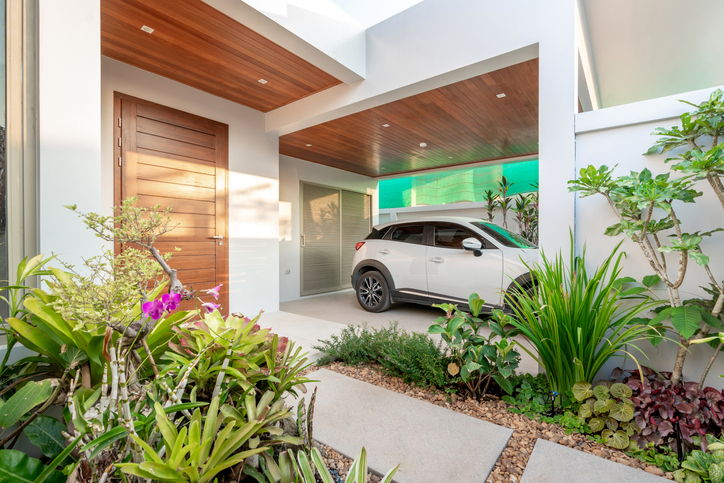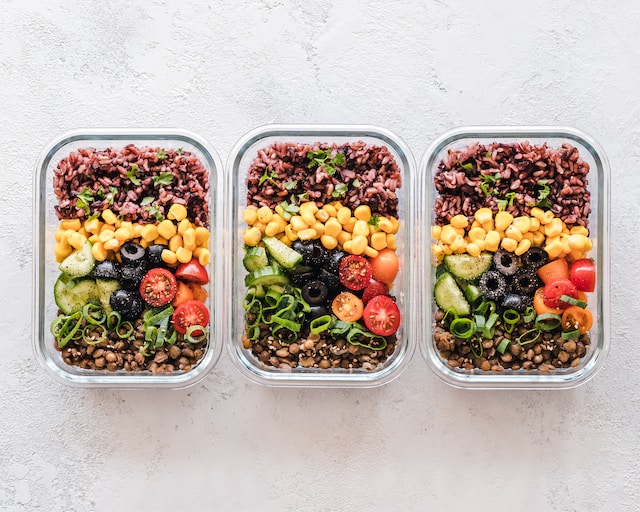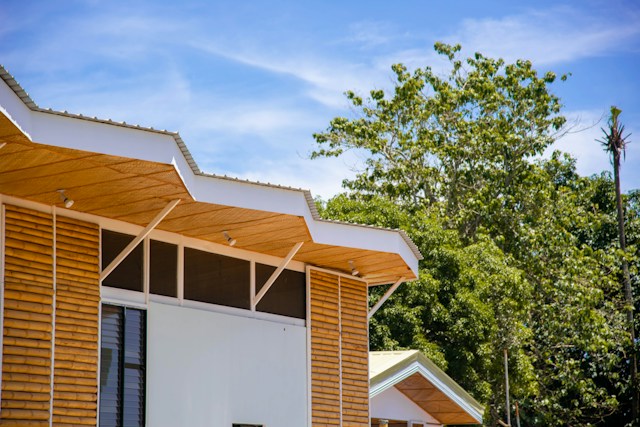A carport is a structure that houses your car. Unlike most garages, a carport doesn’t need to be connected to the home (though it certainly can be) and often lacks four walls to house the vehicle. Carports typically consist of support pillars and a roof to protect people and vehicles from the elements.
The benefits of carports
If you don’t own a garage or need extra space for cars, there are many reasons to consider a carport for your parking needs.
Protects your car from the elements
A carport protects your car from the weather. Car storage options – garages included – aren’t completely immune to forces of nature, but a carport helps protect against the following:
- Rain – Rain deteriorates a car’s paint job and can cause rust over time. If water manages to get into the engine, serious mechanical problems may occur.
- Snow – Snow also causes rust. It gets heavy when it settles, and the weight can deteriorate your windshield’s stability over time.
- Hail – Hail isn’t exactly a common occurrence, but it happens. If your car spends most of the winter outside in the open, a hailstorm could likely dent the vehicle or crack the windshield.
- UV rays – UV rays can severely discolor your vehicle’s paint or even cause dents and cracks in the car’s roof.
- Wind – Wind is mostly harmless but can blow damaging debris, rain, and hail at your vehicle.
Versatility
A carport is a versatile space. It’s shielded from the rain and often not attached to the home, making it an ideal outdoor workspace for projects requiring large materials unsuited for use inside a home. Many carports don’t have walls, but you can erect tarps or galvanized steel to protect you and your equipment from the weather while working outside. A carport is a great space for car maintenance and repairs, welding, woodworking, and general construction.
On a hot day, you can also use a carport as a shaded patio. It provides cover and ventilation while using the grill and is a great place to sit in the shade. A carport can also act as extra storage. Depending on what you want to store, you may need to add some walls for extra protection.
Increases home value and adds curb appeal
A potential buyer will see the benefits of having a carport to keep their vehicles out of the elements. Many people build carports for the extra space, even if they own a garage. The curb appeal increases if the carport is attractive and matches the home aesthetically.
Green energy
A lot of carports are turning green, in a sense. Solar carports are increasing in popularity, and not just because of the advantages listed above. Solar panels on your carport roof increase your home’s energy. If your car is electric, you can charge it with solar power. A solar carport makes you eligible for many subsidies and tax advantages, and it’s great for the environment.
Types of carports

Carports come in several different varieties:
Freestanding carport
Freestanding carports are the simplest to design and erect. Because they’re not attached to any building, you can maneuver them however you want. Freestanding carports offer:
- Freedom in styling – Match your carport to your home, fencing, or garden aesthetic. The beauty of a freestanding carport is you get to stylize it however you choose.
- Easy and quick installation – In general, freestanding carports are quick and easy to build, making them one the most affordable options available.
- Lightweight and portable – Build a handy moveable carport that you can set up in any location you wish.
Open-sided carport
An open-sided carport consists of a basic frame and a roof. This type of carport doesn’t have walls, which means less protection against the elements compared to other varieties. The open-sided carport has some big advantages:
- Affordable and quickly installed – This carport is a simple, no-nonsense building that functions exactly as advertised. Building this style of carport is quick and relatively inexpensive.
- Easy to maintain – These basic carports don’t require a lot of maintenance.
Skillion carport
A skillion carport has a slanted roof with a singular directional pitch. The skillion design was built with the impact of weather in mind. They offer:
- Special design – The slanted roofs were built to handle water runoff and catch UV Rays.
- Simple and easy installation – Usually, the roofs on a skillion carport are made of one solid sheet of material, making it quicker to build.
- Affordable – Simplicity in design means affordability. Using a single material is great for saving costs.
Gable roof carport
Gable roof carports are also known as pitched roof carports. These carports have slanting sides with gables on the end of them. They’re made from a few different materials, including steel, aluminum, slate shingles, asphalt, and timber. Some benefits of gable roof carports include:
- It looks like a house extension – Most homes have slanted roofs and gables, so this specific carport will seem like it was part of the house all along.
- Traditional style – Gable roofs provide a classic design.
- Durability – These slanted roofs were designed to handle heavy rain and snowfall. For extra protection during storms, install plastic sheets on the sides of the carport.
- Quick and easy installation – Gable roofs are relatively easy to install and don’t require special craftsmanship or skills.
Attached carport
Attached carports are connected directly to the home. If your home doesn’t have a connecting roofline to attach to, these additions can be pricey. Some benefits to attached carports include:
- Sheltered pathway – Since the carport is attached to your home, you maintain a roof over your head as you enter or exit the vehicle.
- Better security – The closer your car is to your home, the less likely it will be a target for thieves and other criminals.
Dutch gable carport
The Dutch gable roof carport has a specific Dutch flair to the aesthetic. It has a triangular pitch at the center, with both ends turned vertically halfway through and a Dutch gable on both ends. The benefits of the Dutch gable carports are:
- Aesthetics – These gables are perfect for colonial and heritage homes with a deep-rooted sense of history.
- Patio – The aesthetics also double as a beautiful setting for a patio or outdoor entertainment area.
Flat roof carport
Technically, this carport’s roof is not actually flat. It has a slight slant, which is one of its benefits:
- Allows rainfall to flow easily – The slight slant in a flat roof carport allows rain to flow off it easily, protecting the vehicle.
- Flexible design – Since the roof is simplistic in design, it can be made out of several different materials. The aesthetic of the carport is entirely up to you.
Hip roof carport
A hip roof carport looks like a small home. The roof is made of two symmetrical triangles (or trapezoids), placed together. This carport is more complicated to build than the others, so consider hiring a handyman to help you. The benefit of a hip roof carport:
- More secure – Strong wind and weather hit flat or slanted roofs harder than a hip roof carport, making this design more resistant to the elements.
Carport customization: size and material

Carports have no shortage of sizes or materials. Carports don’t need to attach to a home, so they can be built to match the space available or created specifically to a person’s preferences and needs. Different sizes and materials make a difference overall, so be sure to understand your options.
Carport sizes
Carports are sized based on the number of cars they’re intended to safely cover. Keep this in mind if you plan to add more cars in the future. A second car should be able to sit inside a double carport with enough space for a person to enter either vehicle without risking hitting the other vehicle.
Keep in mind that different vehicles need more room when planning a carport with multiple vehicles. A 4WD truck will take up more space than a compact hatchback. If you want to store a trailer or camper, you’ll need to adjust the height of the carport. Here are the most common sized carports:
- Single carport – A single carport is roughly 12 to 18 feet wide. If you have a particularly large vehicle, be sure to size your carport appropriately.
- Double carport – A double carport is between 18 to 24 feet. Ensure your cars aren’t at risk of hitting each other when the doors open. Consider partitioning off each car stall with blinds or vertical decking.
- Tandem carport – A tandem carport is long rather than wide, allowing you to park two cars, one in front of the other. This option isn’t convenient if you need to move the car in the back, but if you don’t have the width for a double carport, a tandem will protect two cars from the elements.
Carport materials
Carports are made from various materials:
- Metal – People gravitate towards metal for its durability against the elements. The roof and frame of a carport can be made from metal, which lasts longer than most other options.
- Steel – Steel is the most common material due to its durability and affordability. Steel varies in quality, but the higher gauge steel tends to outlive the lower gauge competition. Galvanized steel is usually covered in rust-free protection paint.
- Corrugated metal – This metal is commonly used in buildings. Carports made of corrugated metal tend to be portable, as the steel is lightweight and relatively easier to customize. They require level ground to be installed.
- Aluminum – Aluminum offers lightweight durability for a portable or freestanding carport. It can be painted, which sets it apart from other metals. Some companies provide ready-made aluminum kits if you are not particularly handy.
- Alumawood – This is aluminum designed and treated to look like wood. It has a lifespan of up to ten years and provides the elegant touch that wood brings to a building.
- Wood – Wood is an affordable material for a DIY project and eliminates the need for welding. Wood looks classic, but much like a fence, it requires maintenance against the elements to increase its durability and lifespan.
- Polyethylene – Carport roofs are made of polyethylene, while the frame is most often metal. This material is outstanding when it comes to fending off UV rays, water damage, and strong winds.
Pro tips
When considering a carport, here are a few tips to consider:
- Carport standard size – A single car carport is between 12 to 18 feet wide, while a double is between 18 to 24 feet wide.
- Aesthetics – Build some custom storage into the design or mix different or colorful materials while building to make your new carport look amazing.
- Siding gives extra protection – Try a heavy-duty nylon or a canvas cover for extra protection for your vehicle.
- Built-in lighting – Lighting increases visibility within the carport and makes the space more versatile.
- Insurance – Generally, carports can be covered under the same policy that covers your house. However, review your home insurance policy or contact your insurance provider for coverage details.
A carport is a beautiful and versatile addition to a home. They can stand alone or as part of your home, protect against the elements, and function as a multi-use outdoor space. There are many possibilities in terms of style and aesthetics, so look into adding a carport to your home to enhance curb appeal and provide a safe, shady spot for your vehicle.




